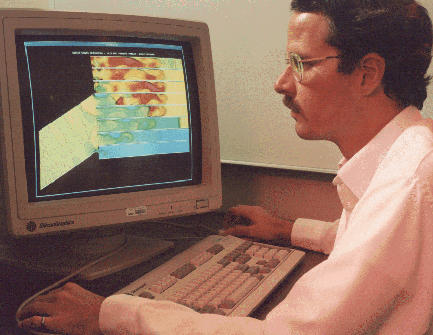 |
|||||
| Home | Research | For Teachers | HISTORY Level 1 Level 2 Level 3 |
PRINCIPLES Level 1 Level 2 Level 3 |
CAREER Level 1 Level 2 Level 3 |
| Gallery | Hot Links | What's New! | |||
| Web Administration and Tools | |||||
 |
|||||
| Home | Research | For Teachers | HISTORY Level 1 Level 2 Level 3 |
PRINCIPLES Level 1 Level 2 Level 3 |
CAREER Level 1 Level 2 Level 3 |
| Gallery | Hot Links | What's New! | |||
| Web Administration and Tools | |||||
![]()
Computational fluid dynamics (CFD) is used to predict and analyze the complex flow physics in engine components. The ability to accurately predict the aerothermodynamic and heat transfer phenomena in turbomachinery and combustor flow fields, including surface thermal loading, is continuously refined through on-going code development and experimental validation. The broad spectrum of CFD work includes turbomachinery performance predictions. One such effort is a time-accurate Navier-Stokes code developed to analyze the unsteady flow in the wave rotor, a turbomachinery component proposed for topping turboshaft engines. The multi-block code models the multiple stationary inlet and outlet ports and the moving rotor passages. The finite-volume form of the governing equations are integrated in time using an explicit Runge-Kutta scheme. The inviscid flux vectors are upwind-differenced to accurately resolve gas dynamic waves. The wave rotor code is used to analyze the details of the passage opening and closing processes and the effects of inlet port geometry variations on the evolution of the rotor flow fields. The code is validated using data from a wave rotor experiment and is providing a prediction of performance of a future wave rotor experiment.
POC: Dr. Gerard E. Welch

Using the CFD code to analyze the Wave Rotor concept
![]()
Send all comments to ![]() aeromaster@eng.fiu.edu
aeromaster@eng.fiu.edu
© 1995-98 ALLSTAR Network. All rights reserved worldwide.
Updated: February 17, 1999